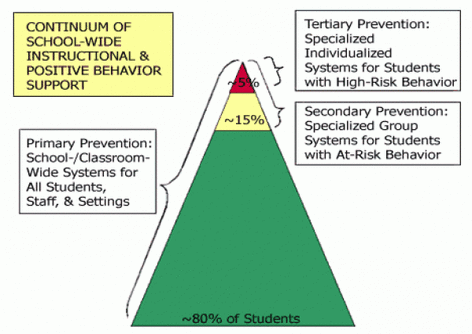PBIS makes a difference.
What is PBIS? Watch the Keynote...
What's with all the Triangles?
The Positive Behavior Support triangle is a way of looking at behaviors within your school. Typically, 80% of students fall within the green zone, which means that they receive less than one referral all year. Typically, 15% of all students fall into the yellow zone, which means they need some intervention to try to put them back into the green zone. 5% of students at most schools fall into the red zone, which flags them for intense intervention.
This is an example of a typical triangle. Every school is different. For more information on your school's triangle, look at your school's PBS page!
Prevention, Prevention, Prevention.

What is Primary Prevention? Primary Prevention involves system-wide efforts to prevent new cases of a condition or disorder. As a system-wide primary effort in schools, positive behavior support consists of rules, routines, and physical arrangements that are developed and taught by school staff to prevent initial occurrences of problem behavior.
What is Secondary Prevention? Secondary Prevention is designed to provide intensive or targeted interventions to support students who are not responding to Primary Prevention efforts. Interventions within Secondary Prevention are more intensive since a smaller number of students within the yellow part of the triangle are at risk for engaging in more serious problem behavior and need a little more support. Individual PBS plans at the Secondary Prevention level involve a simple assessment to identify the function or problem behavior series (Functional Behavioral Assessment or FBA) and a support plan comprised of individualized, assessment-based intervention strategies that include a range of options such as: (1) teaching the student to use new skills as a replacement for problem behaviors, (2) rearranging the environments so that problems can be prevented and desirable behaviors can be encouraged, and (3) monitoring, evaluating, and reassessing this simple plan over time
What is Tertiary Prevention? Tertiary Prevention focuses on the needs of individuals who exhibit chronic behavior problems. Tertiary Prevention involves a comprehensive approach (in a collaborative manner) to understanding and intervening with the behavior, and should use multi element interventions. The goal of Tertiary Prevention is to diminish problem behavior and, also, to increase the student's adaptive skills and opportunities for an enhanced quality of life. Tertiary Prevention involves a process of Functional Behavioral Assessment (FBA) and a support plan compromised of individualized, assessment-based intervention strategies, including a wide range of options such as: (1) guidance or instruction fro the student to use new skills as a replacement for problem behaviors, (2) some rearrangement of the antecedent environment so that problems can be prevented and desirable behaviors can be encouraged, and (3) procedures for monitoring, evaluating, and reassessing of the plan as necessary. In some cases, the plan may also include emergency procedures to ensure safety and rapid de-escalation of severe episodes (this is required when the target behavior is dangerous to the student or others), or major ecological changes, such as cases where more substantive environmental changes are needed.
What is Secondary Prevention? Secondary Prevention is designed to provide intensive or targeted interventions to support students who are not responding to Primary Prevention efforts. Interventions within Secondary Prevention are more intensive since a smaller number of students within the yellow part of the triangle are at risk for engaging in more serious problem behavior and need a little more support. Individual PBS plans at the Secondary Prevention level involve a simple assessment to identify the function or problem behavior series (Functional Behavioral Assessment or FBA) and a support plan comprised of individualized, assessment-based intervention strategies that include a range of options such as: (1) teaching the student to use new skills as a replacement for problem behaviors, (2) rearranging the environments so that problems can be prevented and desirable behaviors can be encouraged, and (3) monitoring, evaluating, and reassessing this simple plan over time
What is Tertiary Prevention? Tertiary Prevention focuses on the needs of individuals who exhibit chronic behavior problems. Tertiary Prevention involves a comprehensive approach (in a collaborative manner) to understanding and intervening with the behavior, and should use multi element interventions. The goal of Tertiary Prevention is to diminish problem behavior and, also, to increase the student's adaptive skills and opportunities for an enhanced quality of life. Tertiary Prevention involves a process of Functional Behavioral Assessment (FBA) and a support plan compromised of individualized, assessment-based intervention strategies, including a wide range of options such as: (1) guidance or instruction fro the student to use new skills as a replacement for problem behaviors, (2) some rearrangement of the antecedent environment so that problems can be prevented and desirable behaviors can be encouraged, and (3) procedures for monitoring, evaluating, and reassessing of the plan as necessary. In some cases, the plan may also include emergency procedures to ensure safety and rapid de-escalation of severe episodes (this is required when the target behavior is dangerous to the student or others), or major ecological changes, such as cases where more substantive environmental changes are needed.

